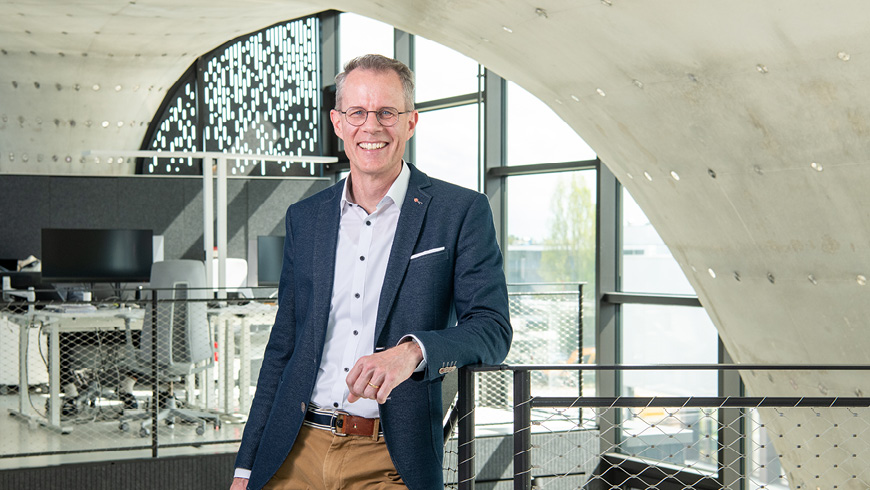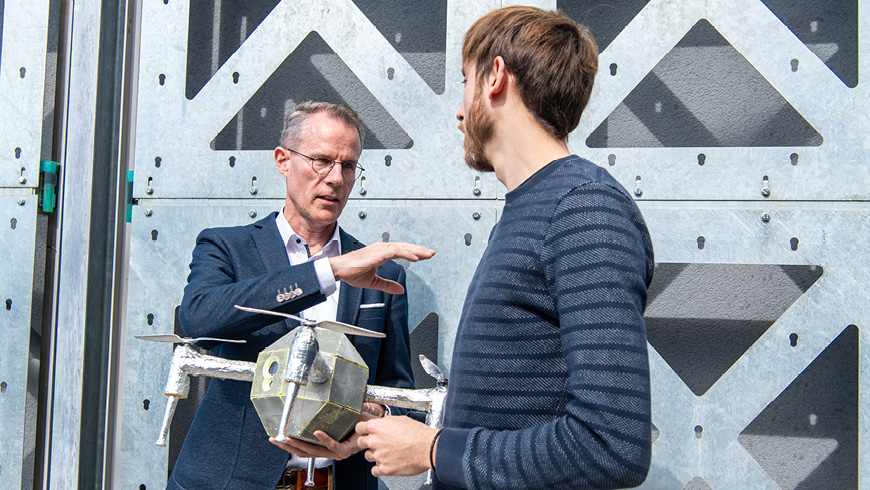Portrait Matthias Sulzer
Building bridges between research and industry
The ETH Board has appointed Matthias Sulzer as a member of Empa's Directorate. Since January 2025, Sulzer is the Head of Empa's Engineering Sciences Department, where he deals with the full range of materials and technologies for the built environment. The engineer is convinced that research and industry mutually benefit each other – a principle that he has lived by throughout his career in both "worlds". The real key to success for him, however, is people.

Organized, neat, tasteful: Matthias Sulzer's office reveals a visual thinker. A hand-drawn poster shows the steps of strategy development: A road winds its way up a mountain, with signposts marking the crucial milestones. "I like to sketch out problems, also as a basis for discussion," says the researcher and engineer. Discussions and meetings are an everyday occurrence in his new role: Sulzer has been head of Empa's Department of Engineering Sciences since January 1, 2025.
His path to this position was just as winding as the metaphorical road on the poster in his office. Sulzer first came into contact with Empa exactly 30 years earlier, while working on his Bachelor's thesis. "It was about the thermal modeling of heat storage systems," he recalls. Research into energy systems would accompany Sulzer throughout his rather atypical career – although for a long time his main focus was not on the academic world.
Application meets research
Even as a boy, Sulzer was the hands-on type. His father, also an engineer, instilled in his son a love of mathematics and technology. Sulzer completed an apprenticeship as a ventilation planner and then enrolled at a university of applied sciences to study engineering, encouraged by his vocational trainer. The joy of learning, combined with his entrepreneurial streak, subsequently led him to the University of New South Wales in Australia for a Master's degree in Business Administration (MBA) with a specialization in Energy Economics.
"At the time, Australia was at the forefront of the renewable energy sector and the university was very international," Sulzer recalls. These experiences shaped him when, shortly afterwards, he founded a company with two partners. What began as a traditional building technology business quickly developed into a pioneering company in the field of energy systems under his leadership. His formula for success: research. At the same time as founding the company, Sulzer was awarded a research contract at the Lucerne School of Engineering and Architecture.
Thanks to this dual role, he was able to bridge the gap in both directions: Innovative solutions and applied research went hand in hand. Novel district heating networks, hydraulic systems for hydroelectric power plants, facilities for the chemical industry – as CEO, Sulzer was happy to take on a wide variety of challenges. Prominent projects followed, including the anergy network at the ETH Hönggerberg campus and the development, planning and construction of the building technology for the high-altitude Monte Rosa hut.
In 2017, his career path took its next turn: Together with his partners, Sulzer took the company public and decided to focus entirely on research – at Empa. He joined Empa's Urban Energy Systems Lab as a senior researcher and took over the management of the cross-institutional Swiss Competence Center for Energy Research: Future Energy Efficient Buildings and Districts (SCCER FEEB&D).
The industry veteran quickly felt at home in the academic environment. "Empa combines excellent research with knowledge transfer to industry," he says – a bridge after his own heart, which beats for both research and engineering.
Research and construction for the climate
The built environment has an enormous impact on the climate and the planet. "95 percent of all man-made materials used in urban areas flow into the construction sector," says Sulzer. His research department at Empa is tackling climate change in three ways: through the decarbonization of energy systems, closed material cycles and the Mining the Atmosphere research initiative, which aims to reuse and recycle atmospheric carbon as a raw material.
The potential for innovation is accordingly high. Sulzer finds it particularly interesting that his department covers the entire range of Empa's vision: materials and technologies for a sustainable future. Research at the department goes beyond the development of sustainable building materials and technologies. "We are also researching innovative solutions in robotics, experimental continuum mechanics and mechanical engineering, with applications in various fields. In the Laboratory for Sustainable Robotics, for example, we are developing drones for autonomous repairs to infrastructure and environmental monitoring. Experimental continuum mechanics provides fundamental findings for the development and use of new materials with improved properties, for example in medical technology. The Mechanical Systems Engineering laboratory focuses on the optimization of metallic materials, plastics and composites for a wide range of applications," explains Sulzer. "And we do this on very different scales, from molecules and chemical interactions to national and international analyses of infrastructures and entire energy systems."

1 + 1 = 3
To prepare his department, Empa, and the Swiss research landscape as a whole for the future, Matthias Sulzer believes one thing is needed above all: people. "Our most important task is to train the next generation of researchers," he says. He sees his role as an enabler of scientific excellence: "I want to create spaces that offer researchers optimal conditions for their work," he says. For him, this also includes interdisciplinary and transdisciplinary collaboration, known as team science. "The traditional academic career path trains researchers to achieve individual excellence," says Sulzer. "That is important and the right thing to do. My aim is to then integrate these excellent researchers into a team in such a way that 1 + 1 doesn't just equal 2, but 3 – a real added value. This is particularly true in interdisciplinary projects, such as the development of biocompatible materials for medical implants, where collaboration between engineers, materials scientists and medtech experts leads to innovative solutions."
He sees putting together and leading effective teams as the greatest challenge and the common thread running through his own career. For him, leadership is not just a matter of talent: Even more important are the right skillset and experience, which Sulzer symbolizes as a kind of leadership keyboard that, over time, acquires more and more playable keys.
However, the department head does not spend his free time playing the piano, but rather climbing – preferably in the great outdoors – and sailing on the Mediterranean. Since his grown-up children have moved out, the family man also enjoys spending time with his wife. To balance out his demanding job as Head of Department, Sulzer has also reserved a small space for research: at the Lawrence Berkeley National Laboratory in the US, which he visits once a year as a visiting scientist. Here, too, the engineer cannot help but build bridges: "The Energy Technology Area at the Berkeley Lab has a similar focus as the Engineering Sciences department at Empa – this leads to a very fruitful exchange," he says.
Career
Matthias Sulzer studied building technology at Lucerne School of Engineering and Architecture, followed by a Master's degree in Business Administration (MBA) with a specialization in Energy Economics at the University of New South Wales in Sydney, Australia. On his return to Switzerland, he and two partners founded a group of companies in the energy and building technology sector, which they successfully took public. He worked part-time at the Lucerne University of Applied Sciences and Arts, where he was involved in various research projects and obtained the title of professor. In 2017, Sulzer joined Empa's Urban Energy System Laboratory as a senior scientist. He has headed Empa's Department of Engineering Sciences since January 2025.
-
Share






